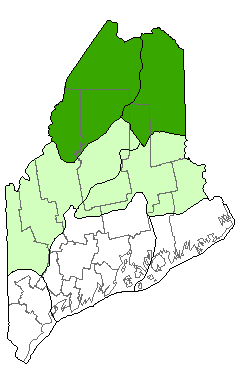DACF Home → Bureaus & Programs → Maine Natural Areas Program → Communities, Plants, and Animals → Natural Community Fact Sheets → Balsam Poplar Floodplain Forest
Printer Friendly Fact Sheet - 1.7 MB pdf (Get a free copy of Adobe Acrobat Reader)
Balsam Poplar Floodplain Forest
Scientific Name: Balsam Poplar Floodplain Forest; State Rank: S2
- Community Description
- Soil and Site Characteristics
- Diagnostics
- Similar Types
- Conservation, Wildlife and Management Considerations
- Distribution
- Characteristic Plants
- Associated Rare Plants
- Associated Rare Animals
- Examples on Conservation Lands You Can Visit
Community Description: These partly open to closed canopy forests are dominated by balsam poplar and occur along medium-sized rivers. This association includes a wide range of early seral, wetland, and floodplain species. These typically include American elm, black or green ash, ostrich fern, lady fern, sensitive fern, blue-joint grass, red-osier dogwood, virgin's bower, speckled alder, dwarf raspberry, broad leaved goldenrod, inflated sedge, and wood nettle. Back to top.
Soil and Site Characteristics: Sites occur on seasonally inundated floodplains or slightly elevated terraces flanking low gradient rivers in central and northern Maine. Sites are often embedded within a matrix of open oxbows and shrub thickets. These forests have lower frequency and duration of flooding than Silver Maple Floodplain Forests. Soils are alluvial fine sand or silt, usually with good drainage capacity. Back to top.
Diagnostics: Sites occupy a floodplain or river terrace setting with mineral soil. Balsam poplar is dominant or co-dominant; black or green ash and American elm may be present. The dense herb layer includes ferns, blue-joint grass, sedges, and shrubs such as red-osier dogwood and speckled alder. Back to top.
Similar Types: Silver Maple Floodplain Forests and Upper Floodplain Hardwood Forests do not have balsam poplar as a dominant or co-dominant. Back to top.
Conservation, Wildlife and Management Considerations: The few known examples of this type have been influenced by past disturbances, including harvesting, beaver damage, and potentially fire. As a result, long term successional trends are not clear. Exotic plant species, which may displace those native to our area, may be easily transported to sites by river waters and represent a threat to the integrity of these forests. The biggest threat may be hydrologic alteration. All known sites in Maine are on private land.
Little data is available on wildlife use of this specific community type, but it is suspected that it would support many of those species associated with Hardwood River Terrace forests in central and northern Maine. Back to top.
Distribution: Narrow floodplains along the shores or islands of medium and smaller rivers in northern Maine, Quebec, and the Maritime Provinces. Landscape Pattern: Small Patch. Back to top.


Characteristic Plants: These plants are frequently found in this community type. Those with an asterisk are often diagnostic of this community.
- Canopy
- American elm
- Balsam fir
- Balsam poplar*
- Black ash
- Dwarf Shrub
- Dwarf raspberry
- Herb
- Blue-joint grass
- Ostrich fern*
- Royal fern
- Sensitive fern
- Wood nettle
There are no documented rare plants associated with this natural community.
There are no documented rare animals associated with this natural community.
Examples on Conservation Lands You Can Visit
There are no documented examples on conservation lands that you can visit associated with this natural community.